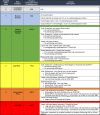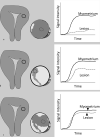Ovary: MRI characterisation and O-RADS MRI
- PMID: 33929901
- PMCID: PMC9327753
- DOI: 10.1259/bjr.20210157
Ovary: MRI characterisation and O-RADS MRI
Abstract
Ultrasound has a high specificity for the diagnosis of a benign lesion in cases of classic appearing simple cyst, hemorrhagic cyst, endometrioma and dermoid. However, ultrasound can sometimes be limited for definitive characterisation and risk stratification of other types of lesions, including those with echogenic content that may appear solid, with or without blood flow. Frequently, MRI can be used to further characterise these types of lesions, due to its ability to distinguish solid tissue from non-tissue solid components such as fat, blood, or debris. Incorporating the MR imaging into the evaluation of adnexal lesions can improve diagnostic certainty and guide clinical management potentially avoiding inappropriate surgery for benign lesions and expediting appropriate treatment for malignant lesions, particularly in the females with sonographically indeterminate adnexal lesions.
Figures









Similar articles
-
O-RADS MRI After Initial Ultrasound for Adnexal Lesions: AJR Expert Panel Narrative Review.AJR Am J Roentgenol. 2023 Jan;220(1):6-15. doi: 10.2214/AJR.22.28084. Epub 2022 Aug 17. AJR Am J Roentgenol. 2023. PMID: 35975887 Review.
-
Added Value of Quantitative Analysis of Diffusion-Weighted Imaging in Ovarian-Adnexal Reporting and Data System Magnetic Resonance Imaging.J Magn Reson Imaging. 2022 Jul;56(1):158-170. doi: 10.1002/jmri.28003. Epub 2021 Nov 19. J Magn Reson Imaging. 2022. PMID: 34797013
-
The Roles of Ovarian-Adnexal Reporting and Data System US and Ovarian-Adnexal Reporting and Data System MRI in the Evaluation of Adnexal Lesions.Radiology. 2024 Aug;312(2):e233332. doi: 10.1148/radiol.233332. Radiology. 2024. PMID: 39162630 Review.
-
O-RADS MRI Classification of Indeterminate Adnexal Lesions: Time-Intensity Curve Analysis Is Better Than Visual Assessment.Radiology. 2022 Jun;303(3):566-575. doi: 10.1148/radiol.210342. Epub 2022 Mar 1. Radiology. 2022. PMID: 35230183
-
O-RADS MRI scoring system: key points for correct application in inexperienced hands.Insights Imaging. 2024 Apr 12;15(1):107. doi: 10.1186/s13244-024-01670-3. Insights Imaging. 2024. PMID: 38609573 Free PMC article.
Cited by
-
MRI in female pelvis: an ESUR/ESR survey.Insights Imaging. 2022 Mar 28;13(1):60. doi: 10.1186/s13244-021-01152-w. Insights Imaging. 2022. PMID: 35347481 Free PMC article.
-
Performance of IOTA Simple Rules Risks, ADNEX Model, Subjective Assessment Compared to CA125 and HE4 with ROMA Algorithm in Discriminating between Benign, Borderline and Stage I Malignant Adnexal Lesions.Diagnostics (Basel). 2023 Feb 25;13(5):885. doi: 10.3390/diagnostics13050885. Diagnostics (Basel). 2023. PMID: 36900029 Free PMC article.
-
Salient magnetic resonance imaging findings in the differential diagnosis of benign, borderline and malignant ovarian mucinous tumors.Abdom Radiol (NY). 2025 Feb;50(2):1009-1017. doi: 10.1007/s00261-024-04545-9. Epub 2024 Aug 27. Abdom Radiol (NY). 2025. PMID: 39187694
-
O-RADS MRI to classify adnexal tumors: from clinical problem to daily use.Insights Imaging. 2024 Jan 30;15(1):29. doi: 10.1186/s13244-023-01598-0. Insights Imaging. 2024. PMID: 38289563 Free PMC article.
-
Navigating Ovarian-Adnexal Reporting and Data System Magnetic Resonance Imaging (O-RADS MRI): A Review of Its Evolution, Current Advances, and Persistent Challenges in Ovarian Imaging.Cureus. 2025 Jun 25;17(6):e86717. doi: 10.7759/cureus.86717. eCollection 2025 Jun. Cureus. 2025. PMID: 40718198 Free PMC article. Review.
References
-
- Buys SS, Partridge E, Greene MH, Prorok PC, Reding D, Riley TL, et al. . Ovarian cancer screening in the prostate, lung, colorectal and ovarian (PLCO) cancer screening trial: findings from the initial screen of a randomized trial. Am J Obstet Gynecol 2005; 193: 1630–9. doi: 10.1016/j.ajog.2005.05.005 - DOI - PubMed
-
- Greenlee RT, Kessel B, Williams CR, Riley TL, Ragard LR, Hartge P, et al. . Prevalence, incidence, and natural history of simple ovarian cysts among women >55 years old in a large cancer screening trial. Am J Obstet Gynecol 2010; 202: 373.e1–373.e9. doi: 10.1016/j.ajog.2009.11.029 - DOI - PMC - PubMed
-
- Sharma A, Apostolidou S, Burnell M, Campbell S, Habib M, Gentry-Maharaj A, et al. . Risk of epithelial ovarian cancer in asymptomatic women with ultrasound-detected ovarian masses: a prospective cohort study within the UK Collaborative trial of ovarian cancer screening (UKCTOCS. Ultrasound Obstet Gynecol 2012; 40: 338–44. doi: 10.1002/uog.12270 - DOI - PubMed
Publication types
MeSH terms
LinkOut - more resources
Full Text Sources
Medical

